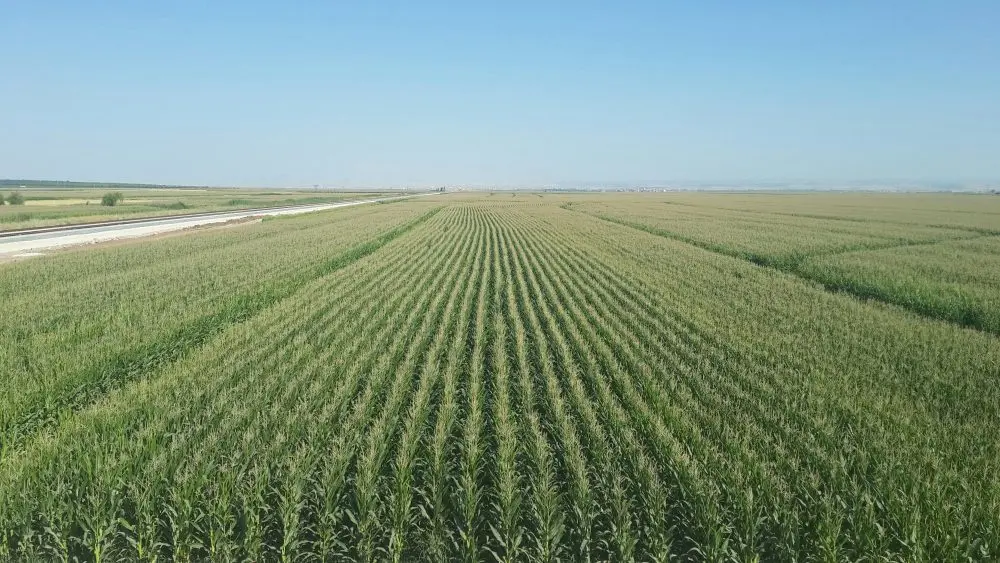ST. PAUL, Minn. — The corn leafhopper (Dalbulus maidis) has been detected again in Minnesota during the 2025 growing season. It was found in one corn field in Waseca County, where adults of the corn leafhopper were captured on yellow sticky traps placed on corn plants at the R5-R6 stage. We deployed yellow sticky traps from June through September, but adults were only captured in September. They can be found on both the adaxial (top) and abaxial (bottom) sides of corn leaves.
Adults generally have a light color, varying from yellow to white, with variable black spots on the abdomen. A key identifying feature is two large black spots on the head above the ocelli (eyes), each more than twice the diameter of the ocelli (Figure 1). This insect can transmit pathogens that cause stunting diseases in corn, leading to symptoms such as reduced growth, red or yellow leaf discoloration, and poor ear development.
Corn leafhopper infestation was first detected in Minnesota in late September 2024 in a corn plot on the University of Minnesota’s St. Paul campus. Both detections of D. maidis in 2024 and 2025 occurred late in the growing season when corn plants were nearing harvest, posing minimal/no risk to the corn plants. However, climate changes such as warmer fall temperatures and more frequent southerly wind events could lead to an earlier arrival of this pest in the future, potentially increasing the risk to late-planted corn. Continued monitoring will be important to track its spread and assess potential risks.
The corn leafhopper is native to Mexico and has been reported throughout much of the southern United States. It is a specialist herbivore closely associated with corn and its wild relatives, capable of long-distance migration and rapid reproduction that enable it to infest multiple fields. But the species cannot survive harsh northern winters. Individuals observed in Minnesota are likely migrants from southern regions, carried northward by storm systems or prevailing winds. The species thrives at temperatures between 25-30°C (77-86°F), but low temperatures in Minnesota could limit its further northward expansion, and no major outbreaks have been recorded to date. Although it reproduces only on corn, corn leafhopper can temporarily survive during the off-season on alternative hosts such as gamma grasses, alfalfa, winter wheat, triticale, and even in moist soil with limited plant material.
For more information, visit https://blog-crop-news.extension.umn.edu/2024/10/first-detection-of-corn-leafhopper-in.html
References
Biles, S. 2024. Leafhoppers in corn: Update. Texas A&M AgriLife Extension, Mid-Coast IPM. https://agrilife.org/mid-coast-ipm/leafhoppers-in-corn-update/
Kerns, D., Führ, F. M., Biles, S., Sekula, D., Santiago-González, J. C., Wilson, G., Mays, T., Drake, D., Isakeit, T., Alabi, O. 2024. Corn leafhopper and the red stunt disease complex. Texas A&M AgriLife Extension, Mid-Coast IPM. https://agrilifeextension.tamu.edu/asset-external/corn-leafhopper-and-the-red-stunt-disease-complex/
Oliveira, C. M., Lopes, J. R. S., Nault, L. R. 2013. Survival strategies of Dalbulus maidis during maize off-season in Brazil. Entomologia Exp. Applicata. 147(2): 141–153.
Faris, A. M., Duffeck, M. 2024. Corn leafhopper leads to corn stunt disease across Oklahoma – August 12, 2024. OSU Extension, Oklahoma State University. https://extension.okstate.edu/e-pest-alerts/2024/corn-leafhopper-leads-to-corn-stunt-outbreak-across-oklahoma-aug-12-2024.html
Valmorbida, I. 2025. Biology and Management of Corn Leafhopper. MU Extension, University of Missouri. https://extension.missouri.edu/publications/g7109
Minnesota in 2025. Photo: Tatum Dwyer, University of Minnesota
